Are you trying to determine whether an electric fence is AC or DC? Or maybe curious about how it works and why AC or DC are important.
In this post, we will explore the different types of electric fences and investigate which type is best. We’ll discuss the pros and cons of both AC and DC systems, as well as provide some practical advice on choosing the right system for your needs.
Let’s get started with diving into what makes an electric fence either AC or DC!
Take away key point:
- An electric fence can be either AC, DC, or solar-powered model, but you need to know your needs to select the proper system
- Both AC and DC fences have their advantages and disadvantages, so ensure you know all of them to choose the best solution
- There are many differences between the systems as well, so learn them in advance to make an informed decision
Table of Contents
- Distinguishing between AC and DC electric fence system
- How are electric fences powered?
- Do electric fences use AC or DC?
- So, is an electric fence system AC or DC?
- What is an AC electric fence charger?
- What is the continuous electric fence charger?
- What is a DC fence charger?
- Wholesome differences between the AC and DC chargers
- Is it better to use the AC or DC charger for the electric fencing?
- What are the advantages of the AC charger?
- What are the disadvantages of the AC-powered charger?
- What are the advantages of the DC charger?
- What are the disadvantages of the DC-powered charger?
- When should you use the AC and when the DC fences?
- Changing electric energy from the AC fence to the DC fence
- Frequently Asked Questions
- Conclusion
Distinguishing between AC and DC electric fence system
If you need to know more about the electric fence system, are electric fences AC or DC, and their main differences, read the guide below. We will answer all your questions.
How are electric fences powered?
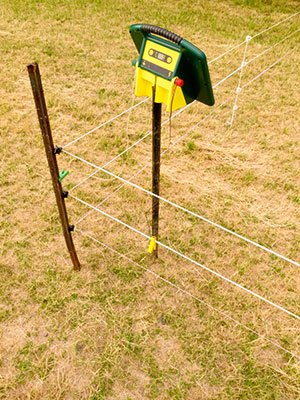
An electric fencing charger, or energizer, is a device used to power electric fences. It can be plugged into a wall socket or powered by a battery. The charger is responsible for regulating the amount of amperage and voltage from the energy source to create an effective electric fence. The strength of the electric current and shock produced by an electric wire is determined by the type and quality of the charger used.
Do electric fences use AC or DC?
Electric fencing usually utilizes either AC chargers or DC chargers depending on their source of power. Electric fencing AC chargers are the preferred option when the fence is plugged into a wall socket. The AC fence charger is safer for animals and has passed UL certification standards for safety and sustainability.
In comparison, DC electric fence wire chargers do not meet such standards. The DC electrified wire chargers should only be used when your non-electric fence wire cannot be connected to a wall socket, as these run off solar or battery power.
So, is an electric fence system AC or DC?
An electric fence can be either AC or DC, depending on your needs. The type of charger used for electric fence wires will determine whether it is AC or DC.
Generally, AC chargers are the preferred option as they deliver a safe, quick shock and require less energy, making them ideal for domestic and wild animals. AC chargers allow electrical energy and electrical pressure to go back to the ground rod and the electric shock will not harm the animals touching the fence line.
In comparison, DC chargers may produce a continuous electric current and electrical pulse produced by the fence controllers. The electrical shock can be harmful, hence why they are not favored as much as AC chargers.
What is an AC electric fence charger?
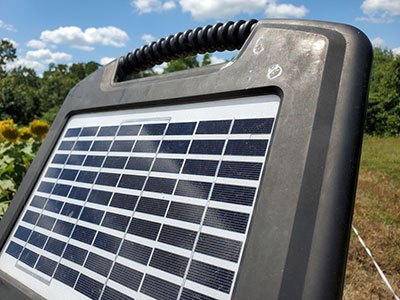
An AC fence charger (electric fence energizer) is a must for an electric fence as it provides a safe, quick shock that only deters the animal rather than hurts them.
The electrical outlet is done by delivering an alternative fence’s electrical circuit that produces a pulse. The electrical circuit makes it easier to break away from the shock and move away from the fence without causing any injury.
What is the continuous electric fence charger?
A Direct Current (DC) charger/electric fence controller is another type of electric fence charger that delivers an uninterrupted flow of electricity into the fence.
The fence energizer differs from an Alternate Current (AC) fence line charger because it does not produce a pulsing shock. Instead, a continuous current can cause injury to animals if they remain in contact with most electric fences for too long.
What is a DC fence charger?
A DC charger is an electric charger that delivers a direct current (DC) and tends to be used when there is a need for a less intense shock. The energizer will only support electric fence wire, not harm the animals or intruders.
This type of electric charger does not require a wall socket and instead works off a large battery or solar power. Additionally, the fence wire charger offers a lower voltage and amperage than an AC charger, which helps to ensure the animal is only deterred rather than hurt.
Wholesome differences between the AC and DC chargers
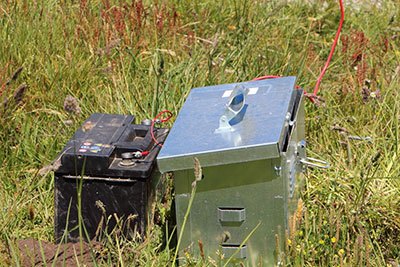
AC electric fences utilize a pulsating current to create a psychological barrier not to be crossed by farm animals or wildlife. This type of fence is highly effective, providing a strong shock that quickly trains animals to stay within their designated area.
In terms of reliability, AC fences are known to be highly effective but require regular maintenance to ensure that the currents are consistent. Furthermore, AC fences are typically more cost-effective than their DC counterparts.
On the other hand, DC electric fences use direct current to power the fence. While DC fences are highly effective with animals with heavier coats, they require a higher voltage of electricity, making them less safe to handle than AC fences. DC fences are more expensive due to the higher voltage of electricity required.
In terms of appropriateness, AC fences are best suited for most agricultural applications, while DC fences are more beneficial in areas with heavy vegetation or for larger livestock such as cattle. The choice of fence ultimately depends on the specific needs of the agricultural application.
Is it better to use the AC or DC charger for the electric fencing?
For electric fences, an AC charger is usually the best option due to its safety features, effectiveness, and low energy usage. However, if there is no available space for an AC charger, it can be converted from a DC charger.
An AC charger delivers short but intense pulses of electricity that will scare animals away instead of trapping them in a continuous shock like that of a DC charger. This helps keep animals safe and secure when near the fence perimeter.
What are the advantages of the AC charger?
An AC charger has many benefits over a DC charger, including increased safety for animals as the pulse of electricity shocks them away instead of trapping them in a continuous cycle of electric energy.
In addition, an AC charger is more economical and reliable due to its plug-in connection to the electrical grid and its consumption of less energy. It also provides a more powerful current that covers larger areas, making it a cost-effective choice. So, if you need the best solution for permanent electric fencing, the AC charger is an ideal option for your boundary fence.
What are the disadvantages of the AC-powered charger?
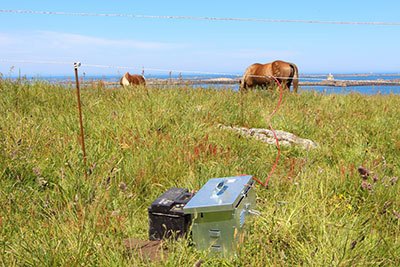
Firstly, they are not portable and are not suitable for long-distance fences. This means that if you need to move your fence or have fencing that is spread over a large area, then AC fence chargers may not be the best option for you.
Additionally, AC-powered electric fence chargers can result in higher operating costs due to increased energy consumption compared to other types of chargers for your boundary fence.
What are the advantages of the DC charger?
DC chargers are ideal for those in rural or remote settings due to their battery and solar power capabilities. This makes them a great choice when no electrical outlets are available or when the fence needs to be moved frequently.
Farmers who move their livestock around often prefer the portability of DC chargers to keep up with their animals’ needs. So, the medium amperage shock is an ideal option for temporary fencing, permit fences, and weed-free fences.
What are the disadvantages of the DC-powered charger?
DC fence chargers have some disadvantages that should be considered before choosing a fence charger for your electric fence needs. One of the biggest disadvantages of DC fence chargers is their reliance on a constant source of electricity.
Unlike solar-powered fence chargers that can work off the grid and have no need for an electrical outlet, DC fence chargers must be connected to a power source at all times.
Additionally, DC fence chargers may not be as efficient as other types of chargers, such as high-impedance electric fence chargers. These types of chargers deliver pulses of high-voltage DC electricity through wires to deter animals with electric shocks, but may not be as effective at long distances or with wet vegetation.
Lastly, DC fence chargers may not be as cost-effective in the long run as they require more maintenance than other types of chargers, such as AC fence chargers or solar-powered electric fences. Keeping a DC fence charger in good working order can become expensive over time due to the need for regular maintenance.
When should you use the AC and when the DC fences?
If you’re setting up an electric fence, you might wonder whether to use an AC or DC charger. The answer is that it depends on your specific needs. If you want a fence with lower voltage and less heat on the wires, then DC may be the best choice for you.
On the other hand, if you want a fence that’s easy to set up and use, an AC charger could be the better choice. Note that an output capacitor is used to store DC electricity between pulses through a fence, while AC can’t be stored.
You could opt for battery-run fence chargers, or a solar-operated fence controller if you want a simpler setup than AC or need to set up the fence in a remote location. Ultimately, the choice between AC and DC fences depends on your specific needs and the characteristics you need for your electric fence.
Changing electric energy from the AC fence to the DC fence
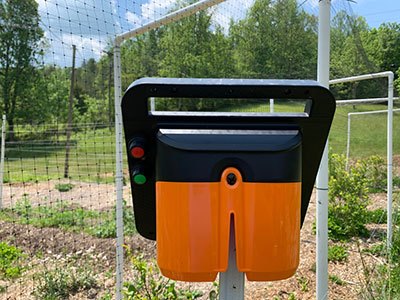
Boosting the power output of a DC charger is possible with the help of a multi-power adapter. This fence post converter allows the DC charger, powered by a battery, to function at 110 volts like an AC charger. The line posts support the energy, guaranteeing maximum power potential.
By using the adapter to convert your DC fence charger to an AC charger, you can enjoy all the benefits of an AC but without any direct connection to an electrical grid.
Frequently Asked Questions
What current is an electric fence?
An electric fence is around 120 milliamps.
Can you test the electric fence with a multimeter?
No, the standard electric multimeter or voltmeter will not work with the fences. Such instruments may damage your systems, as the electricians measure resistance in ohms.
How much DC voltage is in the electric fence?
They put out higher voltage units, around 8,000 volts.
Is solar fencing AC or DC?
The solar fencing is the DC type.
What is the denotative meaning of electrified fence?
The denotative meaning of the electrified fence is a fence with an electric current.
Do electric fences use a lot of electricity?
No, the fences use very little energy.
Is the electric fence output AC or DC?
The output can either be AC, DC, or solar panels. But, the AC type is the most popular method, as it allows you to: maintain constant high tension, it’s ideal for perimeter fences and heavy fence load, access the electric outlet easily.
Conclusion
Fencing is an important factor to consider when deciding how to protect your property from intruders and pests. Whether you choose a conventional AC-powered fence or go green with solar-powered, several concerns about installation and cost need to be taken into account.
Knowing the conditions in your area will help you make a more informed decision on the type of fence you wish to install. All these options provide an excellent choice for reliable fencing systems. It’s important to weigh all of your considerations before making a final decision.
With careful thought and consideration, you can have a fencing system that is both dependable and long-lasting.
